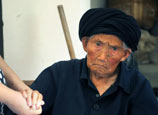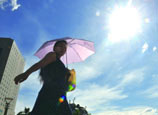
Choose carefully
"Some small schools cannot guarantee safety so it may not be wise to enroll there during summer break," Wu says.
Small schools usually featuring limited space, many students but too few teachers, might go for a more aggressive, results-oriented teaching method, rather than taking it step by step, by the book.
To meet the demand for little ballerinas, private studios increasingly offer dance classes. The best schools release relevant information about teachers and offer reasonable class schedules.
"If an institution can't answer parents' questions, then it's better to be cautious," Wu says.
He and other experts warn that it's wrong to focus on the outcome while ignoring the long and demanding training process.
"It can be dangerous if children are pushed too hard to achieve these results without proper physical development and skill," Wu says.
Sun Guangyan, a retired professor at the Beijing Dance Academy, has cited various problems with dance education in China. Children are taught to dance like adults, which is not suitable, she says, adding that they should dance works that are appropriate to their age, ability and emotion.
The basic problem is that the Chinese public's perception of dance is not mature, she notes.
People think it's fine as long as children can perform a dance, however, ballet is an entire system and science that includes dancing, education, psychology and physiology, she observes.
"As they grow and receive more training, it's still different from the professional level, so parents should understand this and not get too impatient," Wu says.
After three or four years, it's not necessary for a child to be able to dance a complete variation and this is an unrealistic goal, he says. "The right parental attitude also protects children."
Aggressive teaching
Some dance studios say that the earlier children start ballet the better, and they don't pay much attention to whether a child is suited to dancing or not.
"Out of safety considerations, children should be six years old when they start ballet, there's no need to start too early," the ballet master says.
He recommends regulating the dance school industry "because nowadays anyone can start a studio and enroll students. They should be supervised and unqualified schools should be shut down."
Online videos of the China Southern Dance School show astonishing group performances of almost military precision with virtually identical technique, but little beauty, emotion or artistry.
The videos (http://www.56.com/u25/v_NjQ5NjY4OTQ.html) have gone viral for months and generated considerable discussion of dance education in China.
The school called it "a miracle" that dancers achieved such a high level of technical proficiency and synchronization of every move, however, quite a few people called the performances flat and robotic.
This school in Dongguan, Guangdong Province, was involved in a heated discussion last month on a TV program when its regimented teaching methods were criticized by experts. The school posted an open letter on its website saying it can "turn a group of people experts think have no talent into elites." It said that it "accepts anyone."
In contrast to this radical "assembly line" approach to ballet is the Vaganova Method, which is more than 100 years old and the essence of Russian ballet. It is widely used in classical ballet training.
Developed by Agrippina Vaganova (1879-1951), it codifies a technical approach to minimize injuries in training; it emphasizes development of technical proficiency and individual artistry. It teaches not only impeccable precision and execution but also expression of emotion, grace and creativity.
Some dance teachers push too hard and allow students to execute more difficult movements when their ligaments, muscles and joints are not ready.
Dancing on pointe too early is another problem because it requires strict preparation for years and strength in the legs and feet.
"This is not good for dancers' development because being on pointe may cause injuries if it is started before a dancer is old enough and able," Wu says. "Ballet is beautiful but it places very high demands on the body and there will be harm if things are not followed according to plan.
"Another way to judge a ballet school is to see whether they let eager students wear pointe shoes too early in an effort to meet the demands of the market," he says.
 |


















![]()
